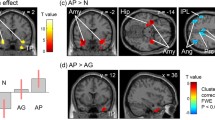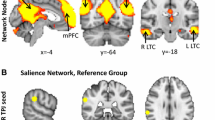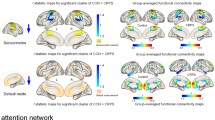Abstract
Pain is a pervasive symptom in lung cancer patients during the onset of the disease. This study aims to investigate the connectivity disruption patterns of the whole-brain functional network in lung cancer patients with cancer pain (CP+). We constructed individual whole-brain, region of interest (ROI)-level functional connectivity (FC) networks for 50 CP+ patients, 34 lung cancer patients without pain-related complaints (CP−), and 31 matched healthy controls (HC). Then, a ROI-based FC analysis was used to determine the disruptions of FC among the three groups. The relationships between aberrant FCs and clinical parameters were also characterized. The ROI-based FC analysis demonstrated that hypo-connectivity was present both in CP+ and CP− patients compared to HC, which were particularly clustered in the somatomotor and ventral attention, frontoparietal control, and default mode modules. Notably, compared to CP− patients, CP+ patients had hyper-connectivity in several brain regions mainly distributed in the somatomotor and visual modules, suggesting these abnormal FC patterns may be significant for cancer pain. Moreover, CP+ patients also showed increased intramodular and intermodular connectivity strength of the functional network, which could be replicated in cancer stage IV and lung adenocarcinoma. Finally, abnormal FCs within the prefrontal cortex and somatomotor cortex were positively correlated with pain intensity and pain duration, respectively. These findings suggested that lung cancer patients with cancer pain had disrupted connectivity in the intrinsic brain functional network, which may be the underlying neuroimaging mechanisms.





Similar content being viewed by others
Data Availability
The study data presented may be made available from the corresponding authors upon reasonable request.
References
Apkarian, A. V., Sosa, Y., Krauss, B. R., Thomas, P. S., Fredrickson, B. E., Levy, R. E., & Chialvo, D. R. (2004). Chronic pain patients are impaired on an emotional decision-making task. Pain, 108(1–2), 129–136. https://doi.org/10.1016/j.pain.2003.12.015
Ashburner, J. (2007). A fast diffeomorphic image registration algorithm. Neuroimage, 38(1), 95–113. https://doi.org/10.1016/j.neuroimage.2007.07.007
Baliki, M. N., Petre, B., Torbey, S., Herrmann, K. M., Huang, L., Schnitzer, T. J., & Apkarian, A. V. (2012). Corticostriatal functional connectivity predicts transition to chronic back pain. Nature Neuroscience, 15(8), 1117–1119. https://doi.org/10.1038/nn.3153
Baliki, M. N., Mansour, A. R., Baria, A. T., & Apkarian, A. V. (2014). Functional reorganization of the default mode network across chronic pain conditions. PLoS One, 9(9), e106133. https://doi.org/10.1371/journal.pone.0106133
Barroso, J., Wakaizumi, K., Reis, A. M., Baliki, M., Schnitzer, T. J., Galhardo, V., & Apkarian, A. V. (2021). Reorganization of functional brain network architecture in chronic osteoarthritis pain. Human Brain Mapping, 42(4), 1206–1222. https://doi.org/10.1002/hbm.25287
Baumbach, P., Meißner, W., Reichenbach, J. R., & Gussew, A. (2022). Functional connectivity and neurotransmitter impairments of the salience brain network in chronic low back pain patients: A combined resting-state functional magnetic resonance imaging and 1 H-MRS study. Pain, 163(12), 2337–2347. https://doi.org/10.1097/j.pain.0000000000002626
Buehlmann, D., Grandjean, J., Xandry, J., & Rudin, M. (2018). Longitudinal resting-state functional magnetic resonance imaging in a mouse model of metastatic Bone cancer reveals distinct functional reorganizations along a developing chronic pain state. Pain, 159(4), 719–727. https://doi.org/10.1097/j.pain.0000000000001148
Buehlmann, D., Ielacqua, G. D., Xandry, J., & Rudin, M. (2019). Prospective administration of anti-nerve growth factor treatment effectively suppresses functional connectivity alterations after cancer-induced bone pain in mice. Pain, 160(1), 151–159. https://doi.org/10.1097/j.pain.0000000000001388
Buvanendran, A., Ali, A., Stoub, T. R., Kroin, J. S., & Tuman, K. J. (2010). Brain activity associated with chronic cancer pain. Pain Physician, 13(5), E337–342.
Chang, P., Fabrizi, L., & Fitzgerald, M. (2022). Early Life Pain Experience Changes Adult Functional Pain Connectivity in the Rat Somatosensory and the Medial Prefrontal Cortex. Journal of Neuroscience, 42(44), 8284–8296. https://doi.org/10.1523/jneurosci.0416-22.2022
Chapman, C. H., Nagesh, V., Sundgren, P. C., Buchtel, H., Chenevert, T. L., Junck, L., & Cao, Y. (2012). Diffusion tensor imaging of normal-appearing white matter as biomarker for radiation-induced late delayed cognitive decline. International Journal of Radiation Oncology Biology Physics, 82(5), 2033–2040. https://doi.org/10.1016/j.ijrobp.2011.01.068
Corbetta, M., & Shulman, G. L. (2002). Control of goal-directed and stimulus-driven attention in the brain. Nature Reviews Neuroscience, 3(3), 201–215. https://doi.org/10.1038/nrn755
Deandrea, S., Montanari, M., Moja, L., & Apolone, G. (2008). Prevalence of undertreatment in cancer pain. A review of published literature. Annals of Oncology, 19(12), 1985–1991. https://doi.org/10.1093/annonc/mdn419
Eccleston, C., & Crombez, G. (1999). Pain demands attention: A cognitive-affective model of the interruptive function of pain. Psychological Bulletin, 125(3), 356–366. https://doi.org/10.1037/0033-2909.125.3.356
Friston, K. J., Williams, S., Howard, R., Frackowiak, R. S., & Turner, R. (1996). Movement-related effects in fMRI time-series. Magnetic Resonance in Medicine, 35(3), 346–355. https://doi.org/10.1002/mrm.1910350312
Frot, M., Faillenot, I., & Mauguière, F. (2014). Processing of nociceptive input from posterior to anterior insula in humans. Human Brain Mapping, 35(11), 5486–5499. https://doi.org/10.1002/hbm.22565
Fuchs, P. N., Peng, Y. B., Boyette-Davis, J. A., & Uhelski, M. L. (2014). The anterior cingulate cortex and pain processing. Front Integr Neurosci, 8, 35. https://doi.org/10.3389/fnint.2014.00035
Greco, M. T., Roberto, A., Corli, O., Deandrea, S., Bandieri, E., Cavuto, S., & Apolone, G. (2014). Quality of cancer pain management: An update of a systematic review of undertreatment of patients with cancer. Journal of Clinical Oncology, 32(36), 4149–4154. https://doi.org/10.1200/jco.2014.56.0383
Henn, A. T., Larsen, B., Frahm, L., Xu, A., Adebimpe, A., Scott, J. C., & Satterthwaite, T. D. (2022). Structural imaging studies of patients with chronic pain: An anatomical likelihood estimate meta-analysis. Pain. https://doi.org/10.1097/j.pain.0000000000002681
Hu, L., Ding, S., Zhang, Y., You, J., Shang, S., Wang, P., & Chen, Y. C. (2022). Dynamic functional network connectivity reveals the brain functional alterations in Lung cancer patients after chemotherapy. Brain Imaging Behav, 16(3), 1040–1048. https://doi.org/10.1007/s11682-021-00575-9
Janelsins, M. C., Kesler, S. R., Ahles, T. A., & Morrow, G. R. (2014). Prevalence, mechanisms, and management of cancer-related cognitive impairment. Int Rev Psychiatry, 26(1), 102–113. https://doi.org/10.3109/09540261.2013.864260
Jenkinson, M., Bannister, P., Brady, M., & Smith, S. (2002). Improved optimization for the robust and accurate linear registration and motion correction of brain images. Neuroimage, 17(2), 825–841. https://doi.org/10.1016/s1053-8119(02)91132-8
Kim, J., Loggia, M. L., Edwards, R. R., Wasan, A. D., Gollub, R. L., & Napadow, V. (2013). Sustained deep-tissue pain alters functional brain connectivity. Pain, 154(8), 1343–1351. https://doi.org/10.1016/j.pain.2013.04.016
Lee, J. J., Lee, S., Lee, D. H., & Woo, C. W. (2022). Functional brain reconfiguration during sustained pain. Elife, 11, https://doi.org/10.7554/eLife.74463
Legrain, V., Iannetti, G. D., Plaghki, L., & Mouraux, A. (2011). The pain matrix reloaded: A salience detection system for the body. Progress in Neurobiology, 93(1), 111–124. https://doi.org/10.1016/j.pneurobio.2010.10.005
Li, H., Li, X., Wang, J., Gao, F., Wiech, K., Hu, L., & Kong, Y. (2022). Pain-related reorganization in the primary somatosensory cortex of patients with postherpetic neuralgia. Human Brain Mapping, 43(17), 5167–5179. https://doi.org/10.1002/hbm.25992
Liu, S., Li, X., Ma, R., Cao, H., Jing, C., Wang, Z., & Wu, J. (2020). Cancer-associated changes of emotional brain network in non-nervous system metastatic non-small cell Lung cancer patients: A structural connectomic diffusion tensor imaging study. Transl Lung Cancer Res, 9(4), 1101–1111. https://doi.org/10.21037/tlcr-20-273
Mansour, A. R., Baliki, M. N., Huang, L., Torbey, S., Herrmann, K. M., Schnitzer, T. J., & Apkarian, V. A. (2013). Brain white matter structural properties predict transition to chronic pain. Pain, 154(10), 2160–2168. https://doi.org/10.1016/j.pain.2013.06.044
Martucci, K. T., & Mackey, S. C. (2018). Neuroimaging of Pain: Human evidence and clinical relevance of central nervous system processes and modulation. Anesthesiology, 128(6), 1241–1254. https://doi.org/10.1097/aln.0000000000002137
Mayr, A., Jahn, P., Deak, B., Stankewitz, A., Devulapally, V., Witkovsky, V., & Schulz, E. (2022a). Individually unique dynamics of cortical connectivity reflect the ongoing intensity of chronic pain. Pain, 163(10), 1987–1998. https://doi.org/10.1097/j.pain.0000000000002594
Mayr, A., Jahn, P., Stankewitz, A., Deak, B., Winkler, A., Witkovsky, V., & Schulz, E. (2022b). Patients with chronic pain exhibit individually unique cortical signatures of pain encoding. Human Brain Mapping, 43(5), 1676–1693. https://doi.org/10.1002/hbm.25750
Meeker, T. J., Schmid, A. C., Keaser, M. L., Khan, S. A., Gullapalli, R. P., Dorsey, S. G., & Seminowicz, D. A. (2022). Tonic pain alters functional connectivity of the descending pain modulatory network involving amygdala, periaqueductal gray, parabrachial nucleus and anterior cingulate cortex. Neuroimage, 256, 119278. https://doi.org/10.1016/j.neuroimage.2022.119278
Mentzelopoulos, A., Gkiatis, K., Karanasiou, I., Karavasilis, E., Papathanasiou, M., Efstathopoulos, E., & Matsopoulos, G. K. (2021). Chemotherapy-Induced Brain effects in Small-Cell Lung Cancer patients: A Multimodal MRI Study. Brain Topography, 34(2), 167–181. https://doi.org/10.1007/s10548-020-00811-3
Moulton, E. A., Becerra, L., Maleki, N., Pendse, G., Tully, S., Hargreaves, R., & Borsook, D. (2011). Painful heat reveals hyperexcitability of the temporal Pole in interictal and ictal migraine States. Cerebral Cortex, 21(2), 435–448. https://doi.org/10.1093/cercor/bhq109
Murphy, K., Birn, R. M., Handwerker, D. A., Jones, T. B., & Bandettini, P. A. (2009). The impact of global signal regression on resting state correlations: Are anti-correlated networks introduced? Neuroimage, 44(3), 893–905. https://doi.org/10.1016/j.neuroimage.2008.09.036
Nijs, J., Lahousse, A., Fernández-de-Las-Peñas, C., Madeleine, P., Fontaine, C., Nishigami, T., & Saraçoğlu, İ. (2023). Towards precision pain medicine for pain after cancer: The Cancer Pain phenotyping Network multidisciplinary international guidelines for pain phenotyping using nociplastic pain criteria. British Journal of Anaesthesia, 130(5), 611–621. https://doi.org/10.1016/j.bja.2022.12.013
Paice, J. A., & Cohen, F. L. (1997). Validity of a verbally administered numeric rating scale to measure cancer pain intensity. Cancer Nursing, 20(2), 88–93. https://doi.org/10.1097/00002820-199704000-00002
Pujol, J., Macià, D., Garcia-Fontanals, A., Blanco-Hinojo, L., López-Solà, M., Garcia-Blanco, S., & Deus, J. (2014). The contribution of sensory system functional connectivity reduction to clinical pain in fibromyalgia. Pain, 155(8), 1492–1503. https://doi.org/10.1016/j.pain.2014.04.028
Reddan, M. C., & Wager, T. D. (2018). Modeling Pain using fMRI: From regions to biomarkers. Neuroscience Bulletin, 34(1), 208–215. https://doi.org/10.1007/s12264-017-0150-1
Scarborough, B. M., & Smith, C. B. (2018). Optimal pain management for patients with cancer in the modern era. C Ca: A Cancer Journal for Clinicians, 68(3), 182–196. https://doi.org/10.3322/caac.21453
Schaefer, A., Kong, R., Gordon, E. M., Laumann, T. O., Zuo, X. N., Holmes, A. J., & Yeo, B. T. T. (2018). Local-global parcellation of the Human Cerebral Cortex from intrinsic functional connectivity MRI. Cerebral Cortex, 28(9), 3095–3114. https://doi.org/10.1093/cercor/bhx179
Seminowicz, D. A., & Moayedi, M. (2017). The Dorsolateral Prefrontal Cortex in Acute and Chronic Pain. The Journal of Pain : Official Journal of the American Pain Society, 18(9), 1027–1035. https://doi.org/10.1016/j.jpain.2017.03.008
Sevel, L., Boissoneault, J., Alappattu, M., Bishop, M., & Robinson, M. (2020). Training endogenous pain modulation: A preliminary investigation of neural adaptation following repeated exposure to clinically-relevant pain. Brain Imaging Behav, 14(3), 881–896. https://doi.org/10.1007/s11682-018-0033-8
Shen, W., Tu, Y., Gollub, R. L., Ortiz, A., Napadow, V., Yu, S., & Kong, J. (2019). Visual network alterations in brain functional connectivity in chronic low back pain: A resting state functional connectivity and machine learning study. Neuroimage Clin, 22, 101775. https://doi.org/10.1016/j.nicl.2019.101775
Simó, M., Vaquero, L., Ripollés, P., Gurtubay-Antolin, A., Jové, J., Navarro, A., & Rodríguez-Fornells, A. (2016). Longitudinal brain changes Associated with prophylactic cranial irradiation in Lung Cancer. Journal of Thoracic Oncology : Official Publication of the International Association for the Study of Lung Cancer, 11(4), 475–486. https://doi.org/10.1016/j.jtho.2015.12.110
Simó, M., Rifà-Ros, X., Vaquero, L., Ripollés, P., Cayuela, N., Jové, J., & Rodríguez-Fornells, A. (2018). Brain functional connectivity in Lung cancer population: An exploratory study. Brain Imaging Behav, 12(2), 369–382. https://doi.org/10.1007/s11682-017-9697-8
Smith, A. M., Leeming, A., Fang, Z., Hatchard, T., Mioduszewski, O., Schneider, M. A., & Poulin, P. (2021). Mindfulness-based stress reduction alters brain activity for Breast cancer survivors with chronic neuropathic pain: Preliminary evidence from resting-state fMRI. Journal of cancer Survivorship: Research and Practice, 15(4), 518–525. https://doi.org/10.1007/s11764-020-00945-0
Stinear, C. M., Coxon, J. P., & Byblow, W. D. (2009). Primary motor cortex and movement prevention: Where Stop meets Go. Neuroscience and Biobehavioral Reviews, 33(5), 662–673. https://doi.org/10.1016/j.neubiorev.2008.08.013
Tan, L. L., & Kuner, R. (2021). Neocortical circuits in pain and pain relief. Nature Reviews Neuroscience, 22(8), 458–471. https://doi.org/10.1038/s41583-021-00468-2
van Ettinger-Veenstra, H., Lundberg, P., Alföldi, P., Södermark, M., Graven-Nielsen, T., Sjörs, A., & Gerdle, B. (2019). Chronic widespread pain patients show disrupted cortical connectivity in default mode and salience networks, modulated by pain sensitivity. J Pain Res, 12, 1743–1755. https://doi.org/10.2147/jpr.S189443
Virgen, C. G., Kelkar, N., Tran, A., Rosa, C. M., Cruz-Topete, D., Amatya, S., & Kaye, A. D. (2022). Pharmacological management of cancer pain: Novel therapeutics. Biomedicine & Pharmacotherapy, 156, 113871. https://doi.org/10.1016/j.biopha.2022.113871
Wang, J., Wang, L., Zang, Y., Yang, H., Tang, H., Gong, Q., & He, Y. (2009). Parcellation-dependent small-world brain functional networks: A resting-state fMRI study. Human Brain Mapping, 30(5), 1511–1523. https://doi.org/10.1002/hbm.20623
Xu, H., Seminowicz, D. A., Krimmel, S. R., Zhang, M., Gao, L., & Wang, Y. (2022). Altered structural and Functional Connectivity of Salience Network in patients with Classic Trigeminal Neuralgia. The Journal of Pain : Official Journal of the American Pain Society, 23(8), 1389–1399. https://doi.org/10.1016/j.jpain.2022.02.012
Yan, C. G., Cheung, B., Kelly, C., Colcombe, S., Craddock, R. C., Di Martino, A., & Milham, M. P. (2013). A comprehensive assessment of regional variation in the impact of head micromovements on functional connectomics. Neuroimage, 76, 183–201. https://doi.org/10.1016/j.neuroimage.2013.03.004
Yeo, B. T., Krienen, F. M., Sepulcre, J., Sabuncu, M. R., Lashkari, D., Hollinshead, M., & Buckner, R. L. (2011). The organization of the human cerebral cortex estimated by intrinsic functional connectivity. Journal of Neurophysiology, 106(3), 1125–1165. https://doi.org/10.1152/jn.00338.2011
Zalesky, A., Fornito, A., Harding, I. H., Cocchi, L., Yücel, M., Pantelis, C., & Bullmore, E. T. (2010). Whole-brain anatomical networks: Does the choice of nodes matter? Neuroimage, 50(3), 970–983. https://doi.org/10.1016/j.neuroimage.2009.12.027
Zhou, X., Tan, Y., Chen, J., Wang, C., Tang, Y., Liu, J., & Zhang, J. (2022). Altered Functional Connectivity in Pain-Related Brain Regions and Its Correlation with Pain Duration in Bone Metastasis with Cancer Pain. Dis Markers, 2022, 3044186. https://doi.org/10.1155/2022/3044186
Zung, W. W. (1973). From art to science. The diagnosis and treatment of depression. Archives of General Psychiatry, 29(3), 328–337. https://doi.org/10.1001/archpsyc.1973.04200030026004
Zung, W. W. (1974). The measurement of affects: Depression and anxiety. Modern Problems of Pharmacopsychiatry, 7(0), 170–188. https://doi.org/10.1159/000395075
Acknowledgements
The authors would like to acknowledge the staff of the Chongqing University Cancer Hospital for technical and administrative support, commentary, and advice. The authors also thank all the volunteers who participated in the study for their kind collaboration.
Funding
This work was supported by the National Natural Science Foundation of China (grant number 82371937 and 82071883); the Natural Science Foundation of Chongqing (grant numbers cstc2021jcyj-msxmX0319 and cstc2021jcyj-msxmX0313); and the Natural Science Foundation of Chongqing (grant number CSTB2022NSCQ-MSX0396).
Author information
Authors and Affiliations
Contributions
X.W., D.L. & J.Z. designed research; X.W., Y.L. & X.L. contributed to the experiments and statistical analysis; Y.L., Y.T., J.Z., J.L., J.C., C.W., X.Z. & Y.T. contributed to MRI and clinical data collection. X.W. & D.L. contributed to the writing of the manuscript. D.L. & J.Z. provided guidance and advice. All authors contributed to the article and approved the submitted version.
Corresponding authors
Ethics declarations
Ethics declarations
The experiment was approved by the Medical Research Ethics Committee of Chongqing University Cancer Hospital (Chongqing, China).
Consent to participate
Signed consent was collected from all participating subjects after being informed of the study description.
Consent for publication
All authors have approved of publishing this manuscript which has been read thoroughly by all of them.
Competing interests
The authors declare no competing interests.
Additional information
Publisher’s Note
Springer Nature remains neutral with regard to jurisdictional claims in published maps and institutional affiliations.
Electronic supplementary material
Below is the link to the electronic supplementary material.
Rights and permissions
Springer Nature or its licensor (e.g. a society or other partner) holds exclusive rights to this article under a publishing agreement with the author(s) or other rightsholder(s); author self-archiving of the accepted manuscript version of this article is solely governed by the terms of such publishing agreement and applicable law.
About this article
Cite this article
Wei, X., Lai, Y., Lan, X. et al. Uncovering brain functional connectivity disruption patterns of lung cancer-related pain. Brain Imaging and Behavior (2024). https://doi.org/10.1007/s11682-023-00836-9
Accepted:
Published:
DOI: https://doi.org/10.1007/s11682-023-00836-9




